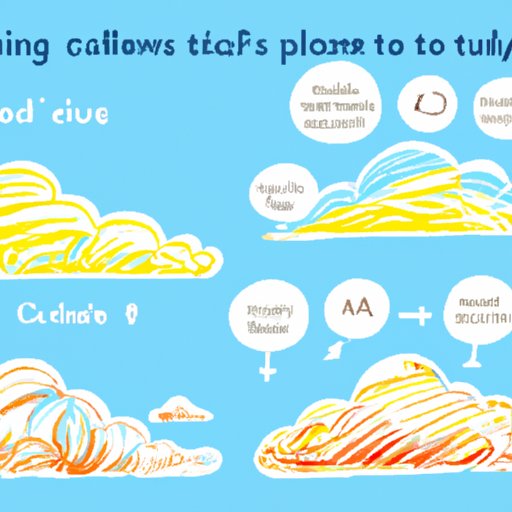
Introduction
Learning how to draw clouds is an essential skill for a variety of artists, from sketch artists to landscape painters. Knowing how to accurately depict the subtle variations in color and form of clouds is key to creating realistic and captivating compositions. With a few basic techniques, anyone can learn how to draw a cloud. In this guide, we’ll provide step-by-step instructions, materials and tips, and different techniques and inspirations for perfecting your cloud drawing skills.
Step-by-Step Guide
Drawing a cloud may seem challenging at first, but with the right technique, it can be easy and fun. First, using a 2B pencil, make a light sketch of the cloud’s basic shape. Start with a circle to outline the cloud’s form, and then add extra curves or bumps to add texture. Once you have the basic shape, darken the outline with a 4B pencil. Then, fill in the cloud with short, light pencil strokes, gradually increasing pressure as you go. Finish up with a white eraser to highlight the edges and create a three-dimensional effect.
Materials and Tips
To ensure the best results with your cloud drawing, use high-quality drawing pencils, such as those made by Faber-Castell or Prismacolor. A pencil sharpener is also a must-have, as sharper pencils create smoother lines and textures. When it comes to paint, watercolor is ideal for capturing the delicate nuances of cloud color and form. Use a fine-bristle brush and a small amount of water to create a light wash, building up the colors gradually until the desired effect is achieved.
Drawing Different Types of Clouds
Clouds come in all shapes and sizes, from fluffy cumulus clouds to wispy cirrus clouds. Each type requires its own set of techniques to capture its unique form and texture. To draw a cumulus cloud, start by creating a round base with small bumps and dips, then add a series of larger puffy shapes to create the illusion of volume. To draw a cirrus cloud, use small, wispy brush strokes to create a feather-like texture, gradually building up the layers until the desired effect is achieved.
Cloud Drawing Techniques
There are a variety of techniques that can be used to create different cloud effects. One technique is stippling, which involves creating tiny dots of various sizes and colors to create a textured surface. Another is cross-hatching, which involves creating a series of overlapping diagonal or perpendicular lines to add shading and depth to the image. For more complex cloud drawings, layering and blending techniques can be employed to achieve a multi-dimensional effect.
Cloud Drawing Challenges
One of the biggest challenges when it comes to cloud drawing is capturing the subtle variations in color and form that make each cloud unique. To overcome this challenge, it is important to study different types of clouds and practice capturing their unique textures and shapes. It can also be helpful to experiment with different materials and techniques to find the right combination for each drawing. Finally, taking a break and stepping back from your drawing can help you gain a fresh perspective and identify areas that need further attention.
Cloud Drawing Inspirations
Finding inspiration for your cloud drawings might seem difficult, but there are many sources to choose from. Look to nature, photographs, and artwork from other artists for ideas and techniques. Movies, books, and poetry often provide vivid descriptions of different types of clouds, which can help you visualize them in your mind’s eye. Finally, take a walk through your own neighborhood or even just gaze up at the sky to find inspiration for your next cloud drawing.
Conclusion
Drawing clouds may seem daunting, but by following a few basic techniques and continuously practicing, anyone can learn how to create captivating and realistic cloud drawings. Remember to study different types of clouds, experiment with different materials and techniques, and take breaks to avoid burnout. With a little effort, cloud drawing can be an enjoyable and rewarding pastime that can add depth and dimension to any composition.





